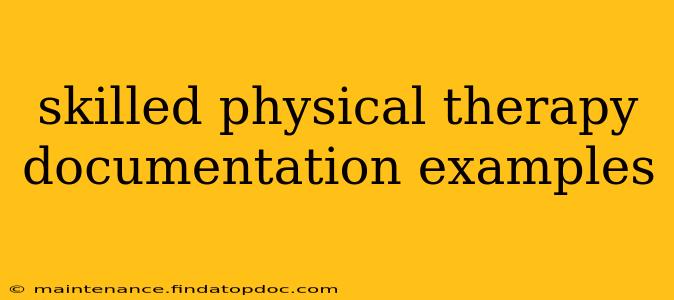Effective physical therapy documentation is crucial for several reasons: it ensures accurate billing, facilitates communication among healthcare professionals, and demonstrates the patient's progress and the effectiveness of the treatment plan. Poor documentation can lead to delays in reimbursement, miscommunication, and ultimately, suboptimal patient care. This guide will explore examples of skilled physical therapy documentation, highlighting best practices and addressing common questions.
What Makes Physical Therapy Documentation "Skilled?"
Before diving into examples, it's essential to understand what constitutes skilled physical therapy. Medicare, and many other payers, define skilled care as requiring the judgment, knowledge, and skills of a physical therapist. This isn't just about performing exercises; it's about the therapist's clinical reasoning and decision-making in assessing, planning, and implementing a treatment plan tailored to the individual patient's needs. Skilled care involves:
- Assessment: A thorough evaluation of the patient's condition, including a comprehensive history, physical examination, and functional assessment.
- Goal Setting: Establishing measurable, functional goals based on the patient's needs and limitations.
- Plan of Care: Developing a customized treatment plan that addresses the identified problems and aims to achieve the established goals.
- Intervention: Implementing skilled techniques and interventions based on the plan of care. This may include manual therapy, therapeutic exercise, modalities, patient education, and more.
- Progress Monitoring: Regularly assessing the patient's progress towards their goals and modifying the treatment plan as needed.
- Discharge Planning: Developing a plan for the patient's continued care after physical therapy concludes.
Skilled Physical Therapy Documentation Examples: Different Scenarios
Let's look at examples demonstrating skilled documentation in various scenarios. Remember, these are illustrative examples and should not be used directly as templates. Always adapt your documentation to reflect the individual patient's needs and your clinical judgment.
Example 1: Post-Surgical Knee Replacement
Patient: 65-year-old female, post-right total knee arthroplasty (TKA), 2 weeks post-op.
Subjective: Patient reports persistent pain (4/10) at rest and 7/10 with weight-bearing. Reports difficulty with ambulation and stair negotiation. States limited range of motion (ROM) in the right knee. Reports improved sleep quality since previous session.
Objective: Right knee ROM: Flexion 90 degrees, extension 0 degrees (improved from 70 degrees flexion, 5 degrees extension last session). Patient demonstrates impaired weight-bearing tolerance, exhibiting antalgic gait pattern. Strength testing: quadriceps 3/5, hamstrings 4/5. Patient completes 10 repetitions of straight leg raises with minimal assistance. Patient utilizes walker for ambulation.
Assessment: Patient continues to demonstrate significant limitations in ROM, strength, and functional mobility secondary to the TKA. Progress is being made in ROM and pain management, but further intervention is needed to improve weight-bearing tolerance and functional ambulation.
Plan: Continue with range of motion exercises, strengthening exercises, gait training with graduated weight-bearing, and patient education. Consider modification of assistive device as tolerance improves.
Example 2: Chronic Low Back Pain
Patient: 40-year-old male, with chronic low back pain (LBP) of 6 months duration.
Subjective: Patient reports persistent dull ache in the lumbar spine (6/10) with intermittent sharp pain (8/10) during movement. Reports difficulty with prolonged sitting and lifting. Reports improved sleep since implementing home exercise program.
Objective: Palpation reveals muscle spasms in the paraspinals. ROM limitations are noted in lumbar flexion, extension, and lateral bending. Straight leg raise test is positive bilaterally. Patient demonstrates poor posture and demonstrates compensations during functional movements.
Assessment: Patient presents with chronic LBP likely related to poor posture, muscle imbalances, and potential facet joint involvement. The patient is demonstrating improvement with the home exercise program.
Plan: Continue with manual therapy techniques, including soft tissue mobilization and joint mobilization. Progress the home exercise program to include core strengthening exercises and functional activities. Educate patient on body mechanics and ergonomic modifications.
Example 3: Stroke Rehabilitation
Patient: 72-year-old male, 3 months post-right cerebrovascular accident (CVA).
Subjective: Patient reports continued difficulty with left-sided weakness and balance. Reports frustration with limitations in activities of daily living (ADLs). Reports increased endurance and less fatigue since last session.
Objective: Left-sided hemiparesis is evident, with decreased muscle tone and strength. Balance testing reveals significant postural instability. Patient requires maximum assistance for transfers and ambulation. Patient demonstrates improved performance on ADLs.
Assessment: Patient continues to exhibit significant neurological deficits secondary to CVA. However, there is evidence of gradual improvement in strength, endurance, and functional mobility.
Plan: Continue with neuromuscular re-education techniques, strengthening exercises, balance training, and ADL retraining. Introduce constraint-induced movement therapy.
Frequently Asked Questions (FAQs)
How much detail is needed in skilled physical therapy documentation?
Sufficient detail is required to justify the medical necessity of skilled physical therapy services. The documentation should clearly demonstrate the patient's condition, the interventions performed, and the patient's progress toward their goals. Avoid vague or generic statements.
What are some common documentation errors to avoid?
Common errors include using pre-printed forms without proper customization, failing to document the patient's progress, and omitting essential information such as the patient's subjective complaints or the objective findings of the examination.
How do I ensure my documentation supports skilled billing?
Your documentation must clearly demonstrate the medical necessity of skilled physical therapy services, the complexity of the case, and the skilled interventions provided by a qualified therapist. It should be specific, complete, and consistently updated to reflect the patient's progress.
This guide provides examples of skilled physical therapy documentation. Remember, always maintain accurate, complete, and timely documentation tailored to your specific patients' needs and clinical judgment. Consult with your facility's compliance department and relevant regulatory guidelines for the most up-to-date information and best practices.
